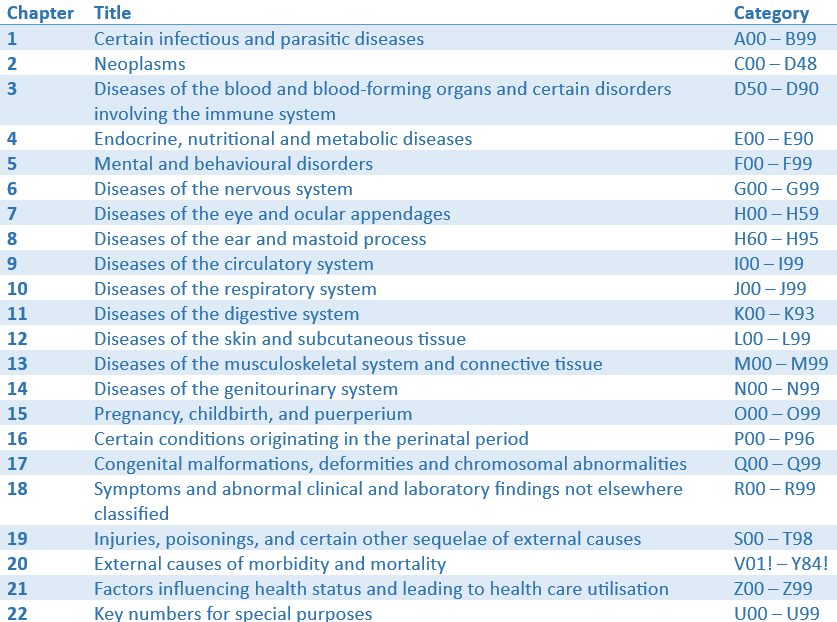ICD Catalogue
The abbreviation ICD stands for “International Statistical Classification of Diseases and Related Health Problems”. The ICD catalogue is compiled by the World Health Organisation (WHO). It is internationally recognised and the most important classification system for medical diagnoses.
The ICD catalogue is used to code medical diagnoses and is used in a wide range of countries, especially in the inpatient sector, but also in the outpatient sector. The latest, 11th version of the WHO catalogue, ICD-11, has been in force since 1 January 2022. The previous version, ICD-10, has been in use since 1994 and was last updated in 2019.
Use of the ICD catalogue in Switzerland
Since 2011, it has been mandatory for all hospitals and clinics in Switzerland to use the German Modification version (ICD-10-GM), which differs from the WHO version, for coding medical diagnoses. The ICD-10-GM is published by the Federal Institute for Drugs and Medical Devices (BfArM) and updated annually. In Switzerland, the new version is usually adopted every two years. This regularity was somewhat interrupted due to COVID-19. Accordingly, ICD-10-GM version 2022, for example, was or will continue to be used in 2022, 2023 and 2024. The Federal Statistical Office (FSO) announces the valid version of the classifications in each case. For use in the Swiss health system, the ICD-10-GM is also translated into French and Italian by the Federal Statistical Office (FSO).
An essential goal of the use of the ICD classification is the uniform coding of diagnoses to enable the statistical analysis of data. In addition, the coding of diagnoses by ICD codes is used in particular in the tariff system in Switzerland. In all three inpatient tariff systems, ICD codes are used to group cases. From 1st January 2026, diagnoses will also be coded using the ICD classification in the outpatient sector as part of the outpatient flat rates.
Structure of the CIM catalogue
The codes in the ICD-10-GM classification catalogue have an alphanumeric structure consisting of a letter in the first position followed by two digits, a dot and one or two decimal places (e.g. I21.0 “Acute transmural myocardial infarction of anterior wall” or I25.11 “Atherosclerotic heart disease: Single-vessel coronary artery disease”). The classification catalogue consists of two parts, the Tabular List and the Alphabetic Index.
Tabular List
The Tabular List is divided into 22 chapters, with the first 17 chapters in particular describing diseases in the stricter sense.

Each of the 22 chapters is divided into individual disease groups, e.g. E10-E14 “Diabetes mellitus”. A group contains different three-digit disease classes (also called categories). As an example, the disease class E10.- “Insulin-dependent diabetes mellitus” can be mentioned here.
The categories are usually further subdivided into four-digit subcategories. This subcategorisation allows coding of localisation, varieties or specific diseases if the category includes a group of affections. To stay with the example above: E10.1 “Insulin-dependent diabetes mellitus: With ketoacidosis” forms a subcategory.
Sometimes there is further refinement and thus five-digit codes (e.g. M23.21 “Derangement of meniscus due to old tear or injury: Anterior horn of medial meniscus”).
Important for coding: Only terminal codes are valid, i.e. only codes for which no further subdivision exists. These can be three-digit, four-digit or five-digit codes of the ICD-10-GM. For correct coding, it is recommended that the first step is to search for the leading term for the diagnosis in the Alphabetic Index and the second step is to use the Tabular List to check the accuracy of the code found and to determine whether further specification is necessary.
Alphabetic Index
The ICD-10 Alphabetic Index supports the search for the correct ICD code. The Alphabetic Index contains search terms for diseases, syndromes, traumas and symptoms.
However, the Tabular List is always decisive for coding. Thus, if the Alphabetic Index leads to a non-specific code, it must always be checked with the Tabular List whether a more specific coding is possible.
Our free online search MedCodeSearch can also help you find the right code. In addition to the ICD catalogue, you can search other catalogues such as the CHOP catalogue or various tariff systems such as SwissDRG or TARMED. The intelligent search function we have implemented makes finding the right code child’s play.
